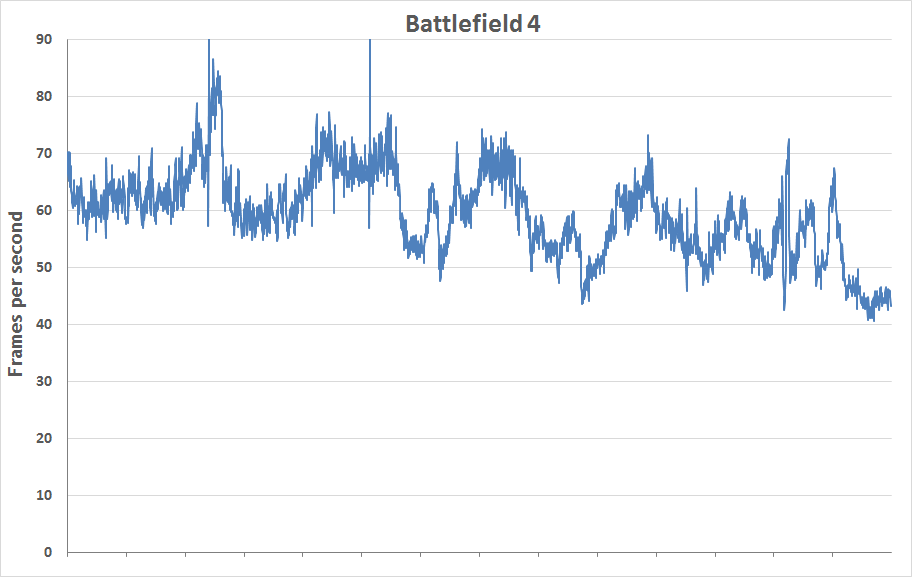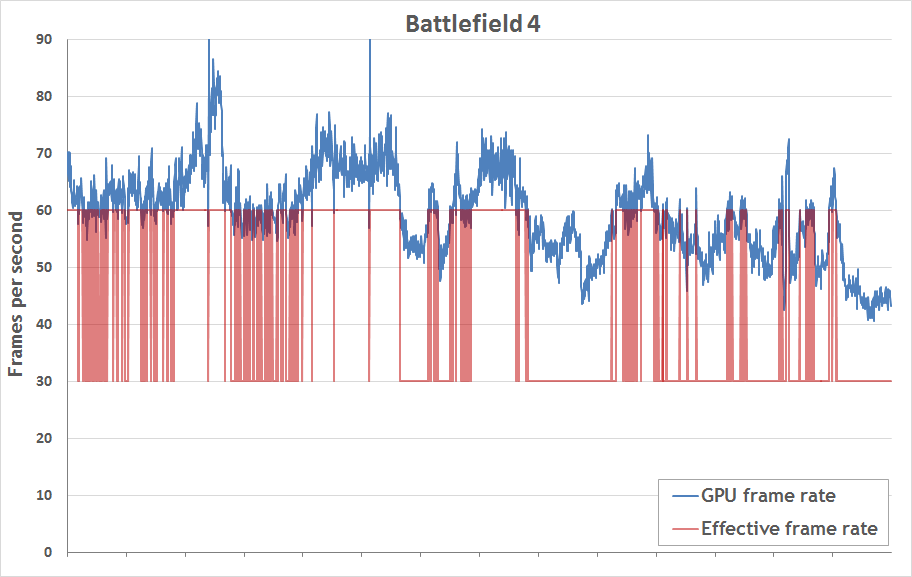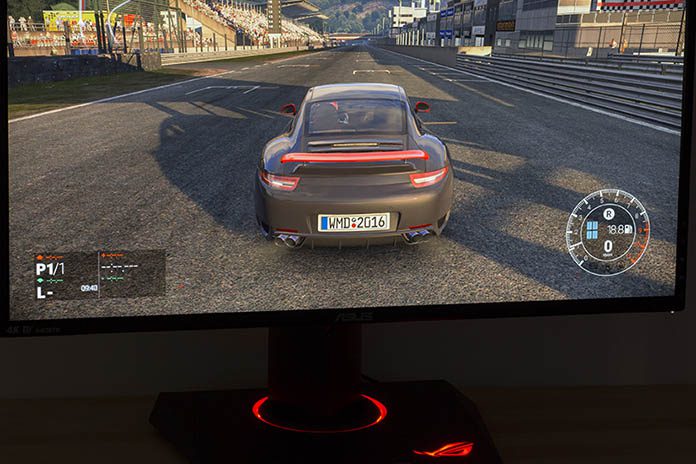Superior graphics are a big part of PC gaming’s appeal. We have the best visuals around, in part because we have the best graphics cards and displays to deliver the action to your eyeballs. Nowhere is that more apparent than on ASUS’ new ROG Swift PG27AQ. The latest member of our expanding family of gaming monitors brings the spectacular sharpness of 4K together with the flawless fluidity of G-Sync.
Combining a 4K IPS panel with NVIDIA’s G-Sync technology is more than just a marriage of convenience and popular buzzwords. G-Sync’s ability to synchronize the display’s refresh rate with the graphics card’s frame rate is critical to maintaining immersion at 4K.
The 3840×2160 “Ultra HD” resolution commonly associated with 4K covers 8.3 megapixels, enough to fill four 1080p monitors. Instead of spreading those out over a super-sized screen, the ROG Swift PG27AQ squeezes them into a single 27” panel at a density of 163 PPI. The resulting pixels are small enough to be invisible to the naked eye, even with your nose pressed up against the screen.
Cramming more pixels into every square inch lets the PG27AQ show games in richer detail, drawing you in deeper. The latest blockbusters look practically lifelike, especially with the texture detail and other eye candy turned all the way up. The catch is that the extra detail isn’t free. To pump out 4K frames at a steady 60 FPS, the graphics card must process roughly half a billion pixels per second, which is a Herculean undertaking considering the complexity of today’s big-budget games. Allow me to illustrate with the ROG Matrix GTX 980 Ti.

With a GeForce GTX 980 Ti GPU clocked 23% faster than stock, the Matrix is easily one of the most powerful graphics cards on the planet. At 4K, it keeps less-demanding games like Counter-Strike and Rocket League comfortably over 60 FPS with everything maxed out, but titles with more intensive graphics present a stiffer challenge. The performance plots below come from 60-second snippets of gameplay on an Ivy Bridge-E system built around the ASUS X79 Deluxe and a Core i7-4960X processor. Individual frame times were collected with Fraps and then converted to FPS. You can click the buttons below the graph to see the performance of different games.

Battlefield 4 and Project Cars mostly hover around 60 FPS, though they frequently drop below that threshold. The frame rates in Shadow of Mordor and Grand Theft Auto V stick closer to 50 FPS overall.
Games generally feel smooth around 45-60 FPS, so the results look good at first glance. But they fail to account for the fact that traditional displays update the screen at a fixed rate. Most monitors refresh at a steady 60Hz—effectively 60 frames per second—regardless of how quickly new frames are generated by the graphics card. This approach is fine for things like desktop applications and videos, where frames are also produced at a fixed rate, but it’s problematic for games, where the frame rate varies constantly.
VSync is typically used to bridge the disconnect. This feature buffers the frames produced by the graphics card to ensure that one is always available at the start of the display’s refresh cycle. The trouble is, there’s a penalty when the time required to generate a frame is longer the interval between cycles. If a new frame arrives even a moment late for the next refresh cycle, an older frame is displayed in its place. You don’t get an updated view of the game until the following cycle.
60Hz displays refresh every 16.7 milliseconds. If you miss that cycle by even by a smidgen, the delay between new frames increases to 33.3 milliseconds, which drops the effective frame rate to just 30 FPS. The plots below approximate the effect on perceived performance using our previous examples. The blue line represents the frame rate measured by Fraps, while the red line shows the effective frame rate at the display.

Whenever the graphics card dips below 60 FPS, the frame rate delivered at the display plunges into “cinematic” console territory. The lower frame rate simply isn’t as smooth, and the abrupt transitions disrupt the look and feel of the game. Every missed cycle also adds input lag, since it lengthens the time required for your actions to reach the screen. In-game movement feels sluggish as a result.
Disabling VSync reduces input lag by bringing fresh information to the screen faster. With VSync enabled, new frames are only introduced at the beginning of each cycle; they’re drawn from top to bottom before the display moves on. Without VSync, new frames are pushed out as soon as they’re ready, even if the display is in the middle of drawing the previous frame.
Although the display can switch frames mid-cycle, the contents of consecutive frames usually differs slightly, leaving visible seams that cut horizontally across the screen. Otherwise known as tears, these imperfections easily attract your gaze, disrupting immersion in the game. They’re more obvious in motion than in static screenshots, especially in games with rapid player or camera movement.

NVIDIA’s G-Sync technology combats the problems that occur with and without VSync by harmonizing the relationship between the graphics card and display. Instead of refreshing at a fixed interval, the display updates only when the graphics card has new frames ready, nullifying the penalty for missed cycles. New frames are drawn in their entirety before initiating the next cycle, which eliminates tearing.
Synchronizing the graphics card’s frame rate with the display’s refresh rate makes sense in theory, and the impact is easily noticeable in practice. Gameplay feels more responsive and immediate even if you don’t have twitchy reflexes. The animation is smoother, too, without any seams or other blemishes to ruin the graphics. G-Sync’s benefits are perfectly suited to the lower frame rates common in 4K gaming, making the technology a natural fit for the ROG Swift PG27AQ.
While G-Sync is an important component of the PG27AQ’s gaming appeal, it’s not the only feature of note. The IPS panel looks absolutely gorgeous regardless of what you’re doing. The colors are vibrant, with over a billion distinct hues and full coverage of the sRGB gamut. Accurate color reproduction combines with the 4K resolution to make the display a dream for photo editing and other content creation.
When you want to share your work—or a split-screen Rocket League session—with a crowd, the PG27AQ’s wide viewing angles prevent the image from washing. The matte screen also keeps reflections and glare at bay, so you can focus on what’s important.

A full slate of height, swivel, tilt, and rotation options let you adjust the display to fit any environment. And, if you want to use a separate monitor arm, the stand can be removed to reveal a VESA-compatible mounting bracket.
As part of the ASUS Eye Care family, the ROG Swift PG27AQ protects your eyes with a flicker-free backlight and configurable blue light filter. The filter blocks up to 70% of harmful blue light, and there are five settings to suit different preferences and times of day. You can easily switch between them using the on-screen display, which is controlled by a little red joystick tucked behind the right edge. Although literally a small detail, the joystick makes menu navigation incredibly intuitive—and much simpler than using competing displays.
HDMI 1.4 and DisplayPort 1.2 inputs are found around back along with an integrated USB hub, audio jack, and 2W speakers. Due to bandwidth limitations 4K input tops out at 24Hz over HDMI and 60Hz over DisplayPort. The new DP 1.3 standard can push 4K at up to 120Hz, but graphics cards that support it aren’t available yet. That’s one of the reasons the PG27AQ’s peak refresh rate is capped at 60Hz. The other is the fact that 4K panel technology is too new to reach substantially higher refresh rates.
If you want to learn more about the ROG Swift PG27AQ, the official product page has complete specifications along with additional details on every aspect of the display. If you’re convinced already, you can grab the monitor right now for $899.

